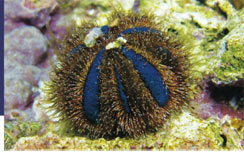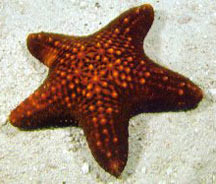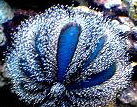Michael Paletta - Guest Author
 |
 |
|
As the hobby of keeping marine animals has evolved, greater emphasis has been placed on keeping a wider diversity of animals. While fish and then corals were the first animals that sparked interest in the hobby, the addition of "nontraditional" animals beyond fish and corals are gaining more attention for their function and role in making a successful reef system complete. |
 Some of these nontraditional animals, such as
clams, are added for their beauty while others, such as
crabs or
shrimp, are added for their interesting behaviors. But more importantly, many echinoderms are now being kept for the important biological tasks they perform as well as their contribution to the long-term success of the reef system. Their varied feeding habits and methods utilize nutrients more efficiently and completely, minimizing the accumulation of excess nutrients in closed systems.
Some of these nontraditional animals, such as
clams, are added for their beauty while others, such as
crabs or
shrimp, are added for their interesting behaviors. But more importantly, many echinoderms are now being kept for the important biological tasks they perform as well as their contribution to the long-term success of the reef system. Their varied feeding habits and methods utilize nutrients more efficiently and completely, minimizing the accumulation of excess nutrients in closed systems.
Many echinoderms are detrivores that feed on the waste of other animals and may even sift through the sand or other substrate in search for it. Other echinoderms may sit under rocks waiting for any morsel of food to come their way while others consume organic material found on live rock, keeping the rocks clean for corals to grow on. Still others consume plankton and other material floating in the water column. Because of these attributes, echinoderms can be considered the garbage collectors of the reef and provide an important service for the overall health of a reef system.
 It should be noted that some of these animals have developed predatory habits and many possess toxins. Owners of these animals should understand the potential risk of keeping them and design the aquarium accordingly. Restraint should be the watchword before adding any of these animals since they can be difficult to remove once they have been released into your reef system.
It should be noted that some of these animals have developed predatory habits and many possess toxins. Owners of these animals should understand the potential risk of keeping them and design the aquarium accordingly. Restraint should be the watchword before adding any of these animals since they can be difficult to remove once they have been released into your reef system.
There are five classes of echinoderms that are commonly kept in the aquarium hobby. These include members of the class
Asteroidea (starfish),
Ophiuroidea (brittle and serpent starfish),
Holothuroidea (sea cucumbers),
Echinoidea (sea urchins), and Crinoidea (feather stars).
Part 1 of 8. Continue reading:
Part 1
Intro |
Part 2
Unique Chararcteristics |
Part 3
Unique Defense Chararcteristics |
Part 4
Sea Stars (Asteroidea) |
Part 5
Brittle & Serpent Starfish (Ophiuroidea) |
Part 6
Sea Cucumbers (Holothuroidea) |
Part 7
Sea Urchins (Echinoidea) |
Part 8
Feather Stars (Crinoidea) |
Biography
Michael Paletta is the author of two books, "The Modern Marine Aquarium" and "Ultimate Reefs," and has acted as a consultant with the National Aquarium in Baltimore and the Pittsburgh Zoo Aquarium. |






